소개
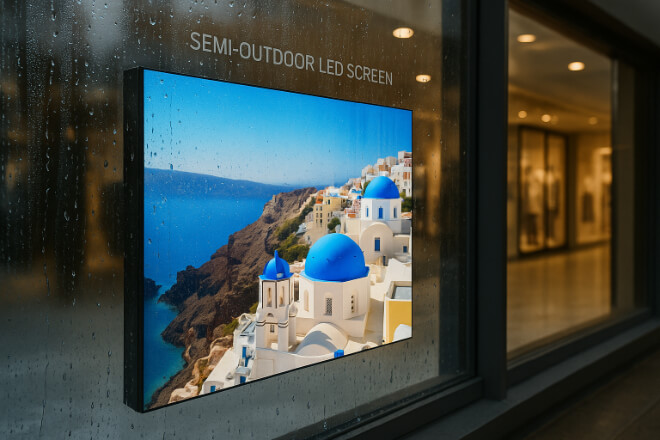
LED 디스플레이 have become an indispensable tool in commercial displays and advertising. However, are you still unsure whether semi-outdoor LED screens are truly rainproof?
This article will reveal the truth about rainproofing for semi-outdoor LED screens and help you make an informed choice.
목차
1. What is a "semi-outdoor LED screen"?
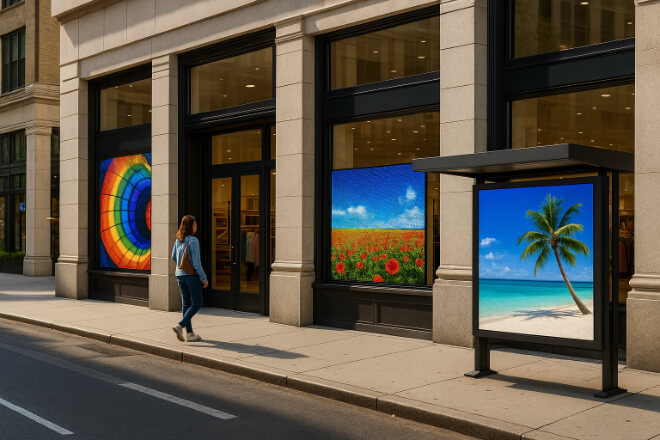
What is a “semi-outdoor LED screen”? Simply put, it’s an LED screen that, while installed indoors, primarily serves people outdoors.
Semi-outdoor LED screens are actually quite common in our daily lives. For example, if you walk into a 쇼핑몰 and see a flashing, colorful screen in a shop window.
Or see advertising screens facing the street at a bus stop, these are typical examples of semi-outdoor LED screens.
This type of screen design has three distinct characteristics. First, its brightness is much higher than that of ordinary indoor screens. 왜?
Because if the 명도 is insufficient in sunlight, the image will be “drowned” by the outside light, becoming blurry.
The high brightness of a semi-outdoor LED screen ensures clear viewing in all lighting conditions.
Second, while it can’t withstand the wind and rain of a fully outdoor screen, it offers a certain degree of protection.
Dust and light rain are no match for it, and the screen remains stable. This is like giving the screen a protective layer, ensuring safety in semi-outdoor environments.
Finally, semi-outdoor LED screens offer a wide 시야각. Passersby can see the content on the screen regardless of their angle.
This greatly increases the reach of information, allowing more people to see advertisements or messages.
In essence, semi-outdoor LED screens act as a bridge between indoor and outdoor spaces.
They leverage the advantages of indoor environments, reducing costs and maintenance, while effectively delivering information to outdoor audiences.
These screens are ideal for use in locations like store windows, mall entrances, and bus stops.
2. How rainproof are semi-outdoor LED screens?
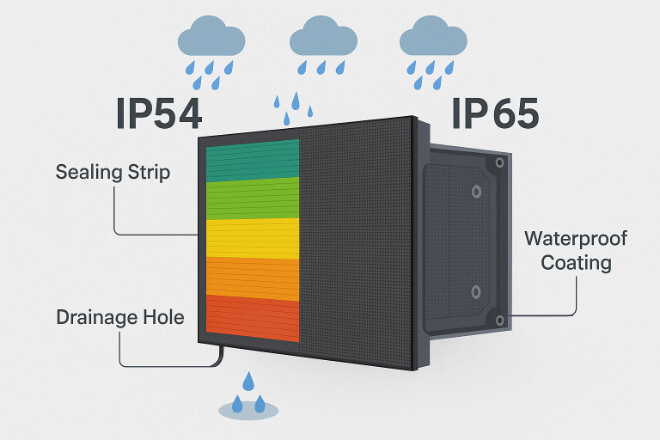
When it comes to the rainproofness of semi-outdoor LED screens, they are actually better than regular indoor screens, but not as rugged as fully outdoor screens.
We typically measure this by their protection rating, with numbers like IP54 and IP65 being common.
Simply put, the higher the number, the more resistant the screen is to dust and water: IP54 is splashproof and generally handles light rain or showers.
IP65 can handle heavier rainfall, allowing the screen to remain operational even in a downpour.
Semi-outdoor screens also feature a number of rainproof features in their design. The screen’s housing is typically equipped with sealing strips to prevent water droplets from seeping in through gaps.
Drain holes are also provided at the bottom to allow rainwater to drain smoothly and prevent it from accumulating inside the screen.
The modules and circuit boards are coated with waterproof adhesive, forming a protective barrier that prevents moisture from damaging the electronic components.
A real-life example is more illustrative: Imagine you’re walking past a shopping mall after work, and the LED screen in the window is playing the latest promotional ads.
Outside, a light rain is falling, and the raindrops are dripping on the glass, but the screen remains clear and smooth, unaffected by the slightest drop of water.
Or, perhaps you’re waiting for your bus at a bus stop and a sudden light shower breaks.
The LED advertising screen inside the booth continues to display bus information and promotional posters, ensuring that passengers can see them at a glance, unaffected by the weather.
Of course, if a storm or multiple days of heavy rain occur, a semi-outdoor LED screen won’t be as reliable as a fully protected outdoor screen.
In such cases, it’s best to take additional protective measures, such as temporarily shielding or shutting down the screen. This ensures the screen’s safety and prolongs its lifespan.
3. How should I assess rain protection risks before purchasing or using a semi-outdoor LED screen?
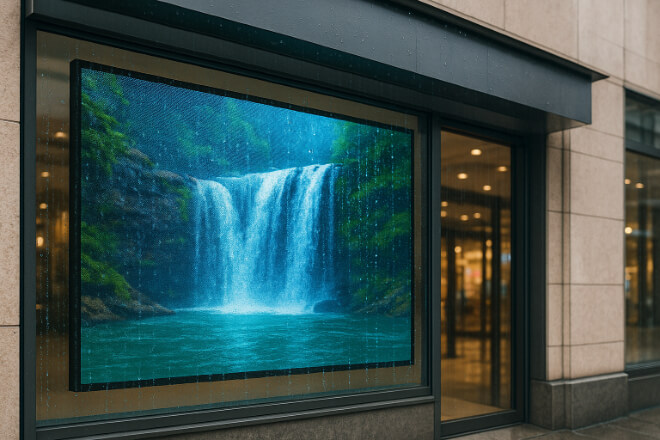
Before purchasing or using a semi-outdoor LED screen, rain protection is essential consideration. The first and simplest step is to check the screen’s IP rating, which acts like a “protection ID card.”
Generally speaking, if your screen will be exposed to outdoor conditions for extended periods, it’s best to choose an IP65 rating or higher. This ensures stable operation in light rain, showers, and even heavy rainfall.
Beyond looking at the numbers, you can also ask the manufacturer directly whether the screen has undergone waterproofing testing to ensure that key protective features like sealing strips, drainage holes, and module glue are functioning effectively.
Furthermore, consider your region’s climate. For example, in the southern rainy season or typhoon-prone areas, where rainfall intensity is high, the screen will withstand significantly greater stress than in the drier north.
Finally, don’t overlook the impact of installation location. If the screen can be installed under an eave or in a semi-sheltered area, even if the IP rating isn’t the highest, it can reduce the risk of rain directly impacting the screen.
For example, the window display at the entrance of a 쇼핑몰 is located under an extended awning, allowing it to remain unscathed even in light rain.
Performing these assessments in advance not only ensures the safe operation of the screen but also extends its lifespan, allowing you to confidently display content even on rainy days without worrying about water damage.
4. How can I improve the rain protection of an existing LED screen?
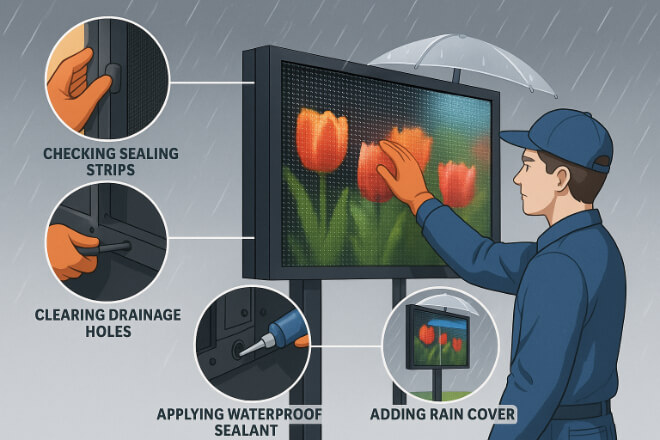
Even if your semi-outdoor LED screen is already in operation, you shouldn’t take it lightly; rain can cause damage at any time.
In fact, improving rain protection isn’t that complicated; a few simple steps can ensure the screen operates safely.
First, regularly inspect the sealing strips and drainage holes. If the sealing strips are deteriorating or the drainage holes are blocked, water can sneak into the screen, affecting the image and circuitry. Don’t wait until problems arise before checking.
Next, applying a secondary sealant to the cable connectors is also very effective. Cable connectors are most susceptible to water leaks, and if water gets in, the screen may short-circuit or experience image malfunctions.
Also, if conditions permit, you can add a transparent rain cover to the screen. This won’t affect the brightness, but it acts like a small umbrella, ensuring stable advertising even in the rain.
Adding a canopy or utilising the eaves of a building is also a simple and effective method.
For example, a small shelter can protect a window screen at a shopping mall entrance from rain, allowing ads to continue displaying even on rainy days.
A slightly extended roof can prevent rain from reaching the screen, allowing information to display normally.
To put it bluntly, these steps aren’t difficult, but the results are significant. With regular attention and a little reinforcement, the screen will function properly even in the rain, maintaining a clear and bright image.
Allowing ads and information to continue displaying smoothly without being disrupted by wind and rain.
5. In what situations is it recommended to upgrade to a "full outdoor LED screen"?
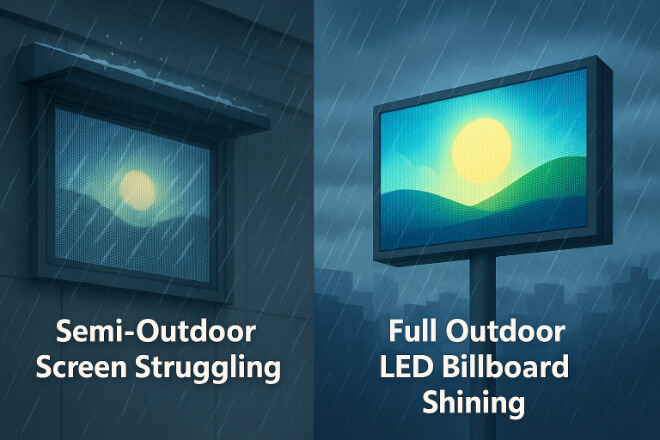
In some cases, a semi-outdoor LED screen may not be able to withstand the pressure, and in these cases, it’s time to consider upgrading to a full outdoor LED screen.
For example, if your screen is exposed outdoors for extended periods without any shelter, subject to wind, sun, and rain daily, a semi-outdoor screen will inevitably struggle in this environment, and minor image issues may occur.
Imagine your area experiencing heavy rain or frequent typhoons. Imagine the rainy season or days of continuous downpours.
While a semi-outdoor screen provides adequate protection, prolonged exposure to water will inevitably lead to degradation or failure.
A fully outdoor LED screen is more reliable in these situations, capable of withstanding all weather conditions and minimising potential issues.
There are also scenarios where content stability is crucial, such as signage at hospital entrances, traffic signs at intersections, or billboards in key shopping districts.
These screens cannot afford to malfunction, as this could compromise information delivery and even pose a safety hazard.
Switching to a fully outdoor screen offers greater protection against wind, rain, dust, and sunlight, ensuring continuous and stable information transmission.
Finally, if the screen’s installation location is inconvenient or maintenance costs are high, upgrading to a fully outdoor screen is recommended.
Fully outdoor screens are generally designed to be more durable and offer enhanced protection.
They can operate reliably even in heavy rain, strong winds, or prolonged sunlight, without the worry of frequent downtime or maintenance hassles.
Upgrading to a fully outdoor LED screen is like “equipping” your screen with full protection.
Even in the most challenging weather, it can safely illuminate and deliver advertisements and information to every passerby.
6. 결론
Are semi-outdoor LED screens rainproof? The answer is revealed. If you want your screen to operate reliably even in the rain, the advice in this article may help.
However, if your application requires extreme rain resistance, a fully outdoor LED screen may be a better choice.
마지막으로 LED 스크린에 대한 자세한 내용은 문의하기.
